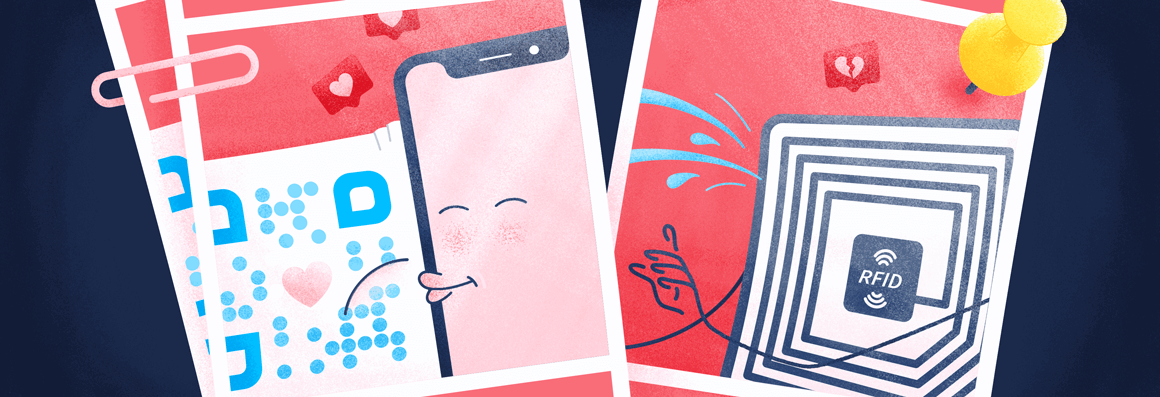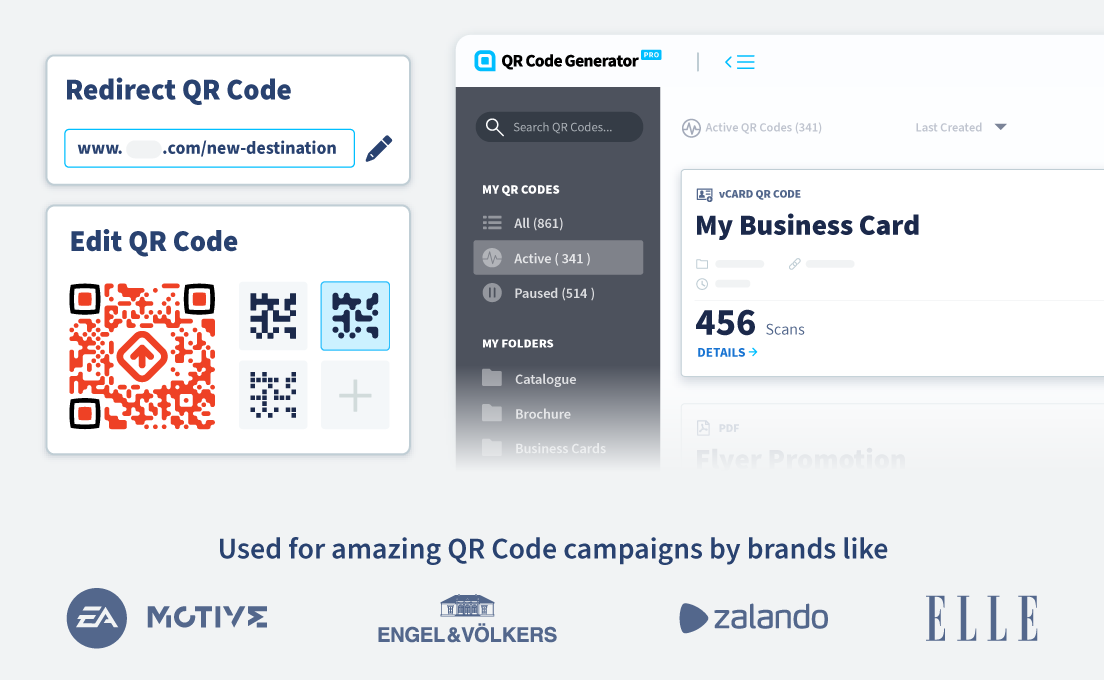- Best Practices ●
- COVID-19 ●
- Industry Trends ●
- Partners ●
- Product ●
RFID Tags vs. QR Codes: What Are the Key Differences to Know?
RFID tags and QR Codes are both used extensively in inventory management systems across the world. But while these two technologies have similar applications, they couldn’t be more different from each other.
RFID tags have been used in fleet management services for years. QR Codes are a newer technology developed as a superior alternative to traditional barcodes. Below, we’ll explore their differences in detail, including how each technology works, their use cases, and why QR Codes offer modern businesses more versatility.
-
Table of contents
- What are RFID tags?
- What are QR Codes?
- Why QR Codes are better than RFID tags
What are RFID tags?
Originally invented in 1980 by Charles Walton, RFID stands for Radio-frequency Identification, meaning it uses a radio to transmit data.
RFID systems have quite an interesting history. Its ancestor was used as a listening device for the Soviet Union just before the Cold War. The device gained popularity until it was developed into a passive radio transponder with memory in 1973 to be used as a toll device.
As demand grew for large product inventories, businesses needed more powerful technology to keep track of individual products—which is when the modern form of RFID technology developed.
How do RFID tags work?
RFID uses electromagnetic fields (radio waves) to identify and track objects with tags. These tags are attached to other objects based on an electronic chip, in which the chip transmits the inventory number to an antenna and then an RFID reader.
A graphic overview of how RFID tags work
There are two types of RFID tags: active and passive. Passive RFID tags are powered by the radio waves themselves and active RFID tags are powered by a battery, making them readable from a distance up to hundreds of meters.
In either case, a special RFID reader is required to transmit the data from the RFID tag to the computer database. Their data capacity is fully flexible depending on the context.
Use cases for RFID tags
In addition to product inventory management and tracking, RFID tags have a wide range of applications. They’re often added to company cars, computer equipment, and even animals during transportation.
Other prominent use cases include:
- Supply chain tracking
- Asset tracking
- Retail and point of sale (POS) systems
- Access control and security systems
- Library management systems
Particularly when an active RFID tag is used, it extends its capabilities to include toll collection, making documents machine-readable, tracking the timing of sports events, and billing processes.
An RFID tag used on a company transportation vehicle
What are QR Codes?
QR Codes were also developed to improve product inventory management systems in 1994, but they don’t use any radio-based technology. Instead, they function much more like a Barcode, which is rectangular and read horizontally.
QR Codes take Barcode technology a step further by using a square shape—meaning they can be read horizontally and vertically.
This feature sped up loading times, increased data capacity, and improved error resistance, which is why they’ve become so cost-effective and widely used today.
QR Codes have better functionality than Barcodes for product inventory management
How do QR Codes work?
QR Codes comprise seven elements that complete their square shape:
- Positioning markings
- Alignment markings
- Timing pattern
- Version information
- Format information
- Data and error correction keys
- Quiet zone
These seven elements determine aspects like how the QR Code encodes data, how much data it holds, the level of error correction, and the quiet zone (space that distinguishes the QR Code from its surroundings).
To read a QR Code’s data, you can simply use any smartphone to scan it with your camera app. Most modern mobile devices have QR Code scanners built into their native camera apps. However, there are several third-party QR Code scanner apps that get the job done if your device doesn’t have one.
Use cases for QR Codes
QR Codes, or quick response codes, can be used for practically any situation where your goal is to provide real-time, convenient access to digital information.
This still applies to product inventory management, but they’re also useful for business and marketing purposes: digital business cards, growing social media followers, sharing images, videos, PDFs, planning events, and much more.
But QR Codes’ usefulness goes far beyond inventory management and marketing. Other creative uses for QR Codes include:
- Showing contactless menus in restaurants
- Displaying recipes in magazines and newspapers
- Processing mobile payments
- Asset management in retail stores
- Providing information to visitors at museums and historical sites
Why QR Codes are better than RFID tags
If you’re comparing RFID tags and QR Codes, QR Codes come out on top in most cases. They don’t need complicated technology to read, have no limit to scan distances, and can even be customized for a particular brand.
And it doesn’t stop there. Below, we’ll look at just a few of the reasons to opt for QR Codes over RFID tags.
Simplified scanning and data readability
While you need a special scanner to read an RFID tag and transmit the data to a computer, you can scan QR Codes with any smartphone. As mentioned above, most modern smartphones have QR Code scanners built in. However, you can always opt for a free third-party QR Code scanning app if needed.
(Looking for more guidance on how to scan QR Codes on your device? Check out our guides for scanning QR Codes on iOS and Android).
When a customer scans a QR Code with their mobile device, the data or content within that QR Code is readable on their smartphone.
For example, let’s say you’re trying to streamline your store’s POS system. Using QR Codes allows your customers to scan the items they want and check out instantly—which isn’t possible with RFID tags.
Scanning a QR Code and viewing its content takes mere seconds and only a smartphone
No limit to scan distance
Even though you can scan active RFID tags from hundreds of meters away, QR Codes can be scanned from extremely far away—and without a battery or power source to power them!
All you need for a QR Code to work is to design the image and add it to any print or digital medium you want. If it needs to be scannable from far away (like a billboard), make the image larger. As long as you maintain the square shape and the image has a high resolution, your QR Code scan distance is limitless.
This makes QR Codes especially useful in marketing and promotional campaigns. For example, a person could scan the QR Code of a marketing poster several feet away while riding the subway.
An example of QR Code scan radius depending on scan distance
Less chance of errors
RFID tags are based on radio wave technology, so if they’re damaged in any way, are out of range from the scanner, or lose battery power, they won’t work.
It makes much more sense to rely on a QR Code because it’s based on a simple image. Plus, their error resistance is up to 30%, meaning that a third of the QR Code can be damaged and still function, making them a much more durable, reliable option.
With RFID tags, you need both hardware and software engineering knowledge to support the technology. But QR Codes are much easier to generate with little to no technical knowledge needed. A robust, intuitive QR Code generator like QR Code Generator Pro makes the process simple—enabling you to create bulk Codes in seconds without worrying about being compromised by external technology.
Customization for branding
One major advantage of QR Codes is branding—something that RFID tags have absolutely nothing of. RFID tags are not meant for marketing because they’re basically just metallic chips placed in silicon.
But QR Codes are becoming an increasingly popular tool because of what they can do for marketing campaigns. First, you can style QR Codes however you like, including brand colors, custom frames with an editable call to action (CTA), different edges, and your logo in the middle.
QR Code customization panel in QR Code Generator
What’s more, QR Codes are downloadable in four different image file formats (JPG, SVG, EPS, PNG), making them easy to customize further and add to your own graphic designs.
Whether you’re running a marketing campaign or finding ways to streamline your inventory management, you can customize all your QR Codes with unique brand elements, such as your logos, colors, and fonts.
Flexible marketing
There’s a QR Code type for virtually any marketing campaign: print, digital, or even a combination of both! If you want to use QR Codes on digital platforms, you can use its short URL.
Every QR Code you design automatically comes with a customizable short URL, which speeds up loading times to the content you connect and gives customers the option to view it via desktop, tablet, or mobile.
Use QR Codes on large-scale billboard ads, print business cards, or even email marketing campaigns.
For example, let’s say that you’re a real estate agency hosting an upcoming open house. Instead of creating and passing out brochures to attendees, you can use QR Codes. This way, attendees can scan the QR Codes to learn more about the home and even automatically add your contact information to their smartphones.
An example of a QR Code in an email marketing campaign
Editing and tracking
There are two further reasons why QR Codes completely beat RFID tags: editability and trackability. While certain types of RFID tags are editable, the process is difficult and requires complex updates to the device itself.
But if you need to edit a QR Code, all you need to do is choose a Dynamic version, and then it’s always updatable from within your QR Code Generator account. You can even completely change your type of QR Code (for example, swap out images for a video) without creating a new QR Code.
A demo version of scan metrics for a QR Code campaign with QR Code Generator PRO
Regarding trackability: Yes, RFID tags are trackable—but not as comprehensively as QR Codes are for marketing.
When you use QR Codes for marketing, you can track the related scan data based on location by city and country, scans over time, operating device used, and unique vs. total scans.
For example, you can track QR Code usage in specific locations. This is a special benefit for marketers who want to see where their ads are most popular. It also helps marketers target specific locations that they know deliver the most scans.
What’s more, you can even integrate QR Code campaigns with Google Analytics to get full insights into the entire customer journey from the initial QR Code scan to the final purchase!
Start using QR Codes today with QR Code Generator PRO
QR Codes and RFID tags are both useful in many different industries for tracking purposes. However, QR Codes reign supreme because they’re easy to create, track, and deploy for bulk use cases.
Ready to leverage the flexibility and versatility that QR Codes can offer your business? Get started with a free QR Code Generator account!






 Add custom colors, logos and frames.
Add custom colors, logos and frames.
